“Intel Faces Critical Yield Problems with Its 18A Process as ‘Panther Lake’ Production Hits Low Conversion Rates”

IIE DIGITAL DESK : Intel’s upcoming 18A chip manufacturing process—central to its plan to reclaim leadership in high-end PC processors—is encountering severe quality and yield issues jeopardizing the viability of its flagship “Panther Lake” laptop chips, two people with direct knowledge told Reuters .
Despite billions of dollars invested in process innovation, factory upgrades, and new facilities, the share of functional chips produced via 18A remains alarmingly low. As of late last year, only around 5% of chips passed quality thresholds; by summer 2025, that number has reportedly climbed to just 10%—still far short of the 70–80% yields typically needed for profitable volume manufacturing .
Intel CFO David Zinsner acknowledged that yields typically improve over time but stopped short of confirming any precise figures. He maintained confidence that the process was on track, though admitted that current yield levels would not immediately generate positive margins .
The root causes stem from the inherent complexity of simultaneously deploying multiple new technologies—an advanced gate-all-around transistor architecture (RibbonFET) coupled with backside power delivery (PowerVia)—within the 18A node. Executing both unproven systems at scale has greatly increased manufacturing risk, prompting insiders to liken the rollout to a “Hail Mary” effort.
Intel aims to begin mass production of Panther Lake chips in late 2025, but with yields so low, many chips may need to be sold at reduced margins—or even at a loss—to meet shipment targets . Historically, Intel needs at least ~50% yields before ramping, with 70–80% needed to break even on a chip this size; without breakthrough improvements soon, that milestone appears out of reach for now .
The implications extend beyond a single product. Intel’s broader strategy includes reviving its contract manufacturing business and competing with foundry giants like TSMC. The shaky trajectory of 18A casts doubt on that ambition. The company has warned that if it cannot secure significant external customers—especially for the next-generation 14A node—it may suspend or exit high-end chip manufacturing altogether .
Leadership changes underscore the company's challenges. Under CEO Lip‑Bu Tan, three senior executives, including Gary Patton, have retired as part of restructuring aimed at refocusing Intel’s foundry operations. Workforce reductions, operational consolidation, and project reassessments—including scaling back on Germany and Poland megafab plans—have been announced as part of a pivot toward cost discipline and risk management .
Despite these setbacks, Intel asserts full speed ahead: it continues preparing for Panther Lake production in 2025 and insists that yield improvements are underway, though specific progress remains unclear .
In short, Intel’s next-gen chipmaking hopes hinge on its ability to rapidly boost yields on the demanding 18A node. If it fails, the consequences could reshape the semiconductor landscape—and signal the end of Intel as a competitive foundry player.
You might also like!















